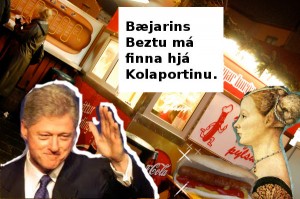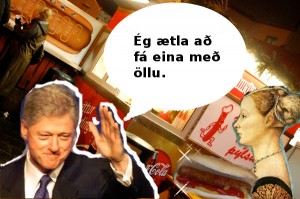A hot dog for Mr. Clinton. Posted by hulda on Jul 9, 2012 in Icelandic grammar
Today I put together a short grammar lesson with some easy rules on the use of hjá, við and með, three prepositions that can all be translated as “with”. The difficulty lies in the different nuances and usage of all three, and getting them mixed up will hardly ever work in a grammatical sense. And since I was feeling nostalgic I decided to illustrate it in style with the ones I myself grew up with* while studying f.ex. English as a child: this is Jack, that is Jill, see Jack run** – you know how those pictures would have looked like, don’t you? But I digress.
(= Bill is planning to buy a hot dog at Bæjarins Beztu***. This really did happen by the way.)
Hjá
Possibly the easiest one of the three, hjá translates also as “beside”, “near”, “at” and “by”. This preposition is a student friendly one in that it only takes a þágufall after it. Hjá refers most often to a location that is next to something, for example:
(= Bæjarins Beztu can be found by Kolaportið.)
Hjá can also be used to describe f.ex. living arrangements – Barnið býr hjá mömmu sinni.
Við
It gets a little bit tricky when it comes to deciding which one of these needs to be used in which occasion, and við is possibly the most difficult to use. I remember asking our professor if there was any rule to the situations that needed við. She thought about it for a moment, shrugged and said in an airy tone:
“You’ll just have to learn it by heart.”
I’m sad to say this but it’s largely true. However, there are at least guidelines to the usage of við which she happily did tell us about in great detail. For example, við is nearly always used with the verb tala (= to speak).
(= Bill tries to speak Icelandic with the lady. Shush, Bill is allowed to do that if he wants to!)
Með
Með tends to be the one most often used to describe being with someone: ég er með vini mínum (= I’m with my friends), or when talking about an item that goes with another item: ég drekk vatn með kaffinu (= I drink water with coffee), mig langar að hafa herbergi með tveimur gluggum (I want to have a room with two windows). Most times með goes with a þágufall. Sometimes, although rarely, með takes a þolfall when it goes with the verbs fara (= to go), koma (= to come) or as a combination vera með (I already wrote about that one here): komdu með kaffið (= Bring over the coffee)!
(= I’d like to have one with everything****. Direct translation would be “I’m going to have one with everything” but it is actually a perfectly polite way of ordering food.)
It can be a little bit difficult to tell við and með apart. Ertu með bókina? Já, hún er á bak við pokann (= Do you have the book? Yes, it’s behind the bag). The difference is not great but it is there: with með the book simply is with you, somewhere, with við it has an exact location.
Við goes most often with þolfall but in some rare cases it can take a þágufall as well. These are usually situations where something is being received – ég tók við peningum af honum (= I received money from him) – or a “reaction” to something is included – svar við bréfi (= a reply to a letter).
Another way that you can try to tell which one you should use is by simple mathematics. First see whether action of any kind is involved because þolfall is more often used to describe that than þágufall. In most cases við, rather than með, takes þolfall, so… er, alas this is not a foolproof method but it still is one that our professor suggested. Well, I did warn you it would not be easy! It might just be best to do it the other way she also suggested and simply learn all the uses of við by heart, one by one as they come.
*Or perhaps the heatwave has softened my will to live and I just couldn’t muster the energy to be creative.
**On some days this still seems to be all I’m capable of, I’m afraid. Here is Ann, there is John, the sun is hot, may I please have a glass of water…
***Bæjarins Beztu is often jokingly called the most well-known restaurant of Iceland. It’s a small hot dog stand by the harbour and famous visitors have indeed included Bill Clinton. They still have a photo of that printed on the stand!
****I’m sorry about this but I – I lied. Bill Clinton only wanted mustard on his hot dog.
PS It struck me that if there are any new readers I should probably translate the case names – þolfall is usually translated as accusative and þágufall as dative. I prefer to use the Icelandic names because the way these cases work is quite unlike what the English translations would let you assume. It may be a little bit confusing at first but I promise that once you study further, using the Icelandic terms may actually help you to make more sense of the grammar rules.

Build vocabulary, practice pronunciation, and more with Transparent Language Online. Available anytime, anywhere, on any device.
About the Author: hulda
Hi, I'm Hulda, originally Finnish but now living in the suburbs of Reykjavík. I'm here to help you in any way I can if you're considering learning Icelandic. Nice to meet you!








Comments:
Verónkia:
Very creative post!
hulda:
@Verónkia Thank you, glad you liked it!
Jonny:
Hi Hulda, great post. I was wondering though, in the sentence:
“Barnið býr hjá mömmu sinni.”
Why does mömmu not have the article? I thought nouns always have the article when followed by a possesive pronoun, like “konunni minni”?
Thanks!
Alejandro:
Could you tell me the meaning of “hjá” in the sentence “hvað er síminn hjá þér” then? Thank you